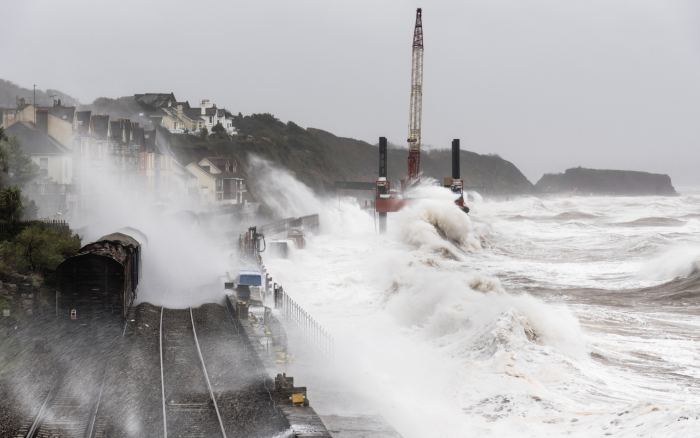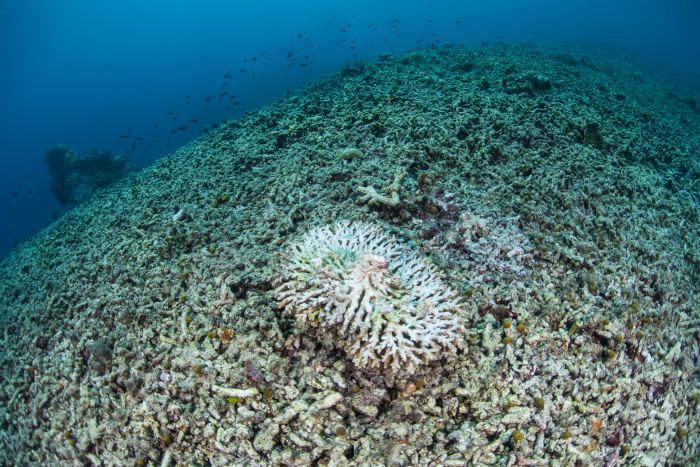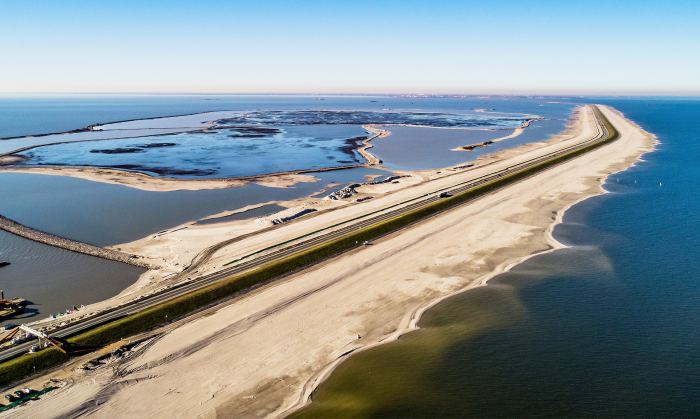Rising sea levels are also rising up the agenda of clients commissioning hydraulic engineering projects, for example for coastal defense and riverbank protection. How big is the problem? What is causing it? And what role can a marine contractor like Boskalis play? We asked Dr. Aimée Slangen, an expert in sea level change at the Royal Netherlands Institute for Sea Research (NIOZ) and as lead author closely involved in the reports of the United Nations’ Intergovernmental Panel on Climate Change (IPCC).
What are the objectives of the NIOZ? And what is the relationship between the NIOZ and the IPCC?
“The NIOZ conducts multidisciplinary research into the functioning of delta and coastal areas, seas and oceans. Our worldwide research is focused on the biological, chemical and physical aspects of the oceans. We regularly conduct marine experiments from the national research vessel that we operate. The NIOZ is also one of the Dutch national organizations that contribute to the IPCC, the Intergovernmental Panel on Climate Change established by the United Nations to analyze and assess climate change. As IPCC lead author I have spent the last few months working almost full-time on our contribution to the forthcoming IPCC Assessment Report 6 (AR6).”
What does the IPCC see as the main causes of climate change?
“The IPCC’s position is that there is indisputable evidence that the emission of greenhouse gases is the principal cause of climate change. During my postdoctoral research in Tasmania in Australia I was part of a team studying the impact of human activity on earlier sea level increases during the twentieth century. That study also showed a clear link between human activity and sea level rise. Countries with coastal areas below sea level in particular are facing a huge challenge which calls for a clear international policy and a joint approach.”
Your area of expertise is oceans, cryosphere and sea level rise. Why is marine research important?
“For a great many reasons. Over 70% of our planet is covered by sea. The oceans form a long-term buffer to capture carbon dioxide from the atmosphere. Healthy, productive oceans, seas and deltas are of immense ecological and economic importance. They are an indispensable source of energy, food and resources, and they are crucial to a multitude of global economic activities. This means that it is essential that we find solutions to major social issues such as pollution, overfishing and the effects of climate change.”
Is there a link between climate change and sea level rise?
“Definitely. You could call sea level rise the climate thermometer. Sea levels tell us a lot about the state of the ocean, the effects of melting ice sheets, the effects of warming, the effects of the difference in hydrology between land and ocean and the effects of ground movements. Sea levels are rising because an increasing amount of energy is being trapped in the climate system due to the emission of greenhouse gases. This energy largely ends up in the oceans, which are warming as a result. Of the extra heat that remains trapped in our ‘Earth system’ as a result of greenhouse gas emissions 93% is absorbed by the oceans. The energy is also absorbed by the ice sheets, causing them to melt. Water increases in volume as it gets warmer, which means that part of the reason sea levels are rising is because the water is warming up. It takes a lot of energy to warm up all the ocean water, but even warming of just one-tenth or a couple of hundredths of centigrade has a measurable effect on sea levels. The warming of the sea water is directly responsible for around half of the sea level rise. The other half is mainly due to the melting of the ice sheets on Greenland and Antarctica and glaciers around the world.”
SEA LEVELS ARE RISING BECAUSE AN INCREASING AMOUNT OF ENERGY IS BEING TRAPPED IN THE CLIMATE SYSTEM DUE TO THE EMISSION OF GREENHOUSE GASES.
Are the increasingly extreme weather conditions also caused by climate change?
“That relationship is the subject of a lot of research. Certainly it is getting clearer all the time that climate change does indeed lead to higher chances of extreme weather conditions. It is not responsible for all extremities but the likelihood of extreme conditions is growing all the time. This means for example that Australia will increasingly be faced with intense bushfires. Not only is the number of inland heatwaves increasing but the phenomenon is also occurring at sea. These so-called marine heatwaves can have a devastating effect on corals and other ocean life. There have been a number of noteworthy marine heatwaves in the past few years. These are caused by sudden changes in current patterns in the ocean and the atmosphere, which lead to a sudden temporary rise in temperature somewhere in the ocean. Five years ago we saw a giant patch of warm water, also known as The Blob, in the northeastern Pacific which had a major negative impact on fish, sea otters and sea lions. Warming of larger sections of the oceans can also trigger tropical storms in other places than we normally see.”
What is the role of the IPCC?
“The IPCC does not carry out original research but analyzes and assesses the many scientific publications issued on this topic. The IPCC’s findings are published in reports which can be used as a basis for political decision-making. In September 2019 the IPCC published the Special Report on the Ocean and Cryosphere in a Changing Climate (SROCC), which was entirely devoted to climate change in the oceans, the ice sheets on Greenland and Antarctica and the glaciers. For us writing the AR6 report, the SROCC report was a kind of an interim update, which we are using as input for the AR6 report, supplemented with new insights that have reached us in the meantime. These new insights are providing increasingly convincing evidence that the climate is changing and what the causes and consequences are. The previous report involved collaboration by more than 300 scientists from 70 countries, supported by almost 450 contributing authors and over 1,700 international reviewers. The group currently working on AR6 is even bigger. The final report will be presented in 2022.”

What does the international community do with these reports? Does the IPCC give an indication of the implications of sea level rise?
“The assessment report consists of three parts. The first part, that I am currently working on, gives a scientific answer to the question of how much the climate is changing including sea level rise. Part two is about the potential implications of these changes. It is being written by a team that assesses the impact on coastal cities and deltas in Europe, Africa, low-lying islands and other at-risk areas. The third part will look at possible adaptive measures and the possibilities for limiting the effects of climate change and reducing greenhouse gas emissions: these are known as mitigating measures. The scientific knowledge presented by the IPCC plays a role in the political decision-making of the 193 countries which have ratified the United Nations Framework Convention on Climate Change (UNFCCC). They weigh the IPCC reporting against other interests, which will hopefully provide a basis for agreements on measures. The climate agreement dictates strict segregation of the responsibilities of scientists and those of politicians and policymakers, meaning that the IPCC plays no role in political decision-making.”
What areas of the world will be impacted most by rising sea levels?
“The biggest impact from rising sea levels is to be expected in countries that do not have the financial means to invest in adequate defenses, such as the low-lying island states of the Pacific. In the Netherlands we should be okay for the time being thanks to our excellent coastal defenses, but things are already different for our neighboring countries. The effect of the melting ice sheets on sea level rise increases with the distance from the ice sheets. This means that sea level rise will be greatest near the equator. This is called the gravitational effect. The ice sheets in Antarctica are so massive that they exert a gravitational pull on ocean water, affecting the earth’s gravitational field. If a lot of ice melts, the gravitational effect weakens; as a result sea levels near Antarctica will fall but will rise much further away, for example in the Netherlands. This means that in the Netherlands we need to be more alert to developments in Antarctica than to those in Greenland.”
OVER 70% OF OUR PLANET IS COVERED BY SEA. THE OCEANS FORM A LONGTERM BUFFER TO CAPTURE CARBON DIOXIDE FROM THE ATMOSPHERE.
Are there any international initiatives to support less wealthy equatorial countries?
“Yes, there is recognition of the fact that there is a major shared responsibility here. Initiatives were taken during the Paris climate summit to establish extra funds. However countries are mainly focused on the possible impact on their own territory. Besides, the causes of the threat differ from country to country. In India and Indonesia for example large areas of land are sinking at above-average speed, thus exacerbating the effect of sea level rise. Conversely, Scandinavia has areas where the ground is rising, where magma in the earth’s mantle is still flowing slowly towards locations which were once covered with ice sheets. As a result the ground is gradually rising back to its original level of thousands of years ago. In some places the ground is rising by as much as one centimeter a year.”

Coral reefs are bleaching due to the rising temperature of the oceans
The media present us with various future scenarios in terms of sea level rise. Can you give us a clear picture?
“The actual extent of the rise will depend on how the world goes about reducing carbon emissions. The rise will not suddenly stop in the year 2100. If global sea levels rise by an average of one meter by 2100, which is not inconceivable, then this rise will probably have doubled by 2200. Even if all the necessary CO2 measures are implemented immediately it will be a while before we start to notice the effects, but we might be able to keep sea level rise under a meter on the long term.”
Will it be possible to adequately defend the low-lying Dutch coast against rising sea levels going forward?
“I don’t believe we will have to give up Amsterdam or Schiphol Airport within the next century. But we do need to start working now on an effective approach. If we want to build new flood defenses like the Delta Works it will take us decades. According to the SROCC report sea levels will rise by four meters by 2300 if there is no change in policy. If we work together at international level we may be able to limit sea level rise to 1-1.5 meters and further slow down the rate of the rise.”
What role do you see hydraulic engineering firms like Boskalis playing in this process?
“The hydraulic engineering sector has a major role to play. As a scientist I can map out the current situation and create models showing how sea level rise will develop. But the knowledge and expertise in terms of the best response really lies with the hydraulic engineering firms. Companies like Boskalis play a principal role in the development of innovative defense measures. I suspect that I am aware of only a few per cent of the practical possibilities. The NIOZ submits regular research proposals to the Dutch government and the European Union. These often involve close cooperation with partners such as Boskalis. Looking ahead, I expect collaboration between scientific research agencies and the hydraulic engineering sector to only get closer in the coming years.”
